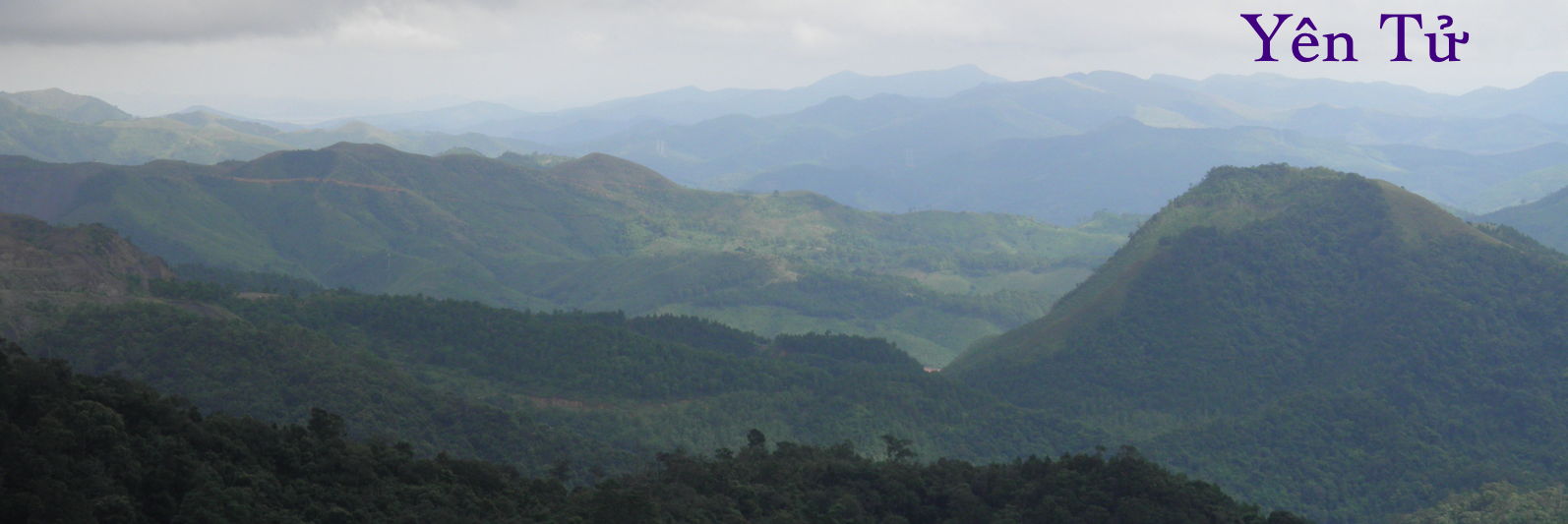Yên Tử: Zen Mountain
The last part of my adventures with Văn was a trip to the mountain ranges to the northeast of Hanoi, which became a place of retreat and Zen practice for the emperors of the Trần dynasty (1225-1400).
The pilgrimage to the top of Yên Tử Mountain. It started out as an innocent excursion, but turned into a grueling ascent far above the clouds (literally). No one really explained how high it was in advance, but my GPS put it at about 3500 feet. We did take a cable car up to about 1700 feet, but the rest of it was incredibly steep, as you'll see.
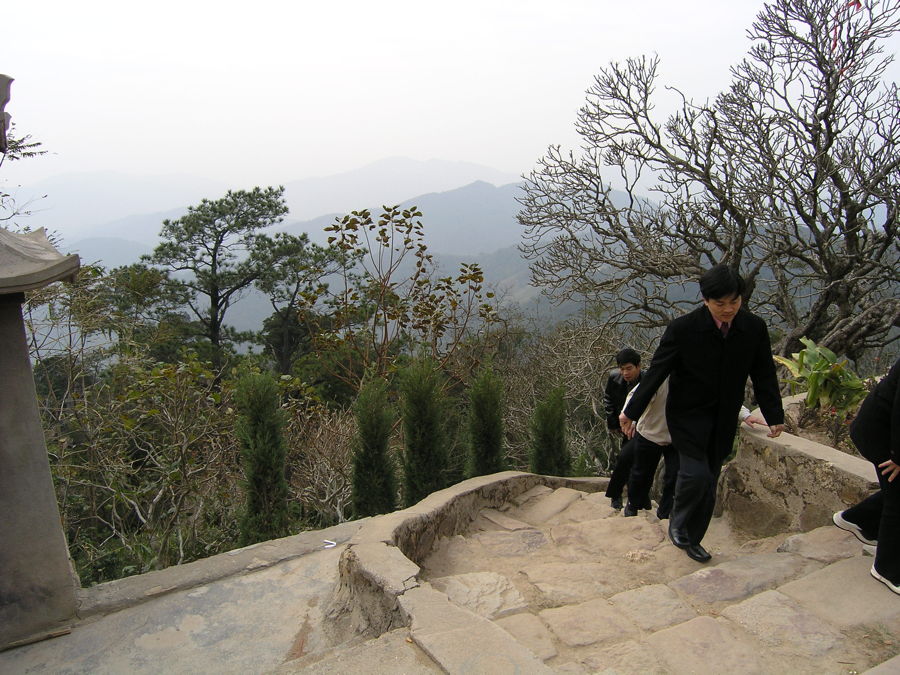
The first stage of the journey, up to the Hoa Yên stupa yard.
Yên Tử Mountain had long been considered a sacred peak; it was noted as "the fourth blessed place on earth" in a geographical book of the Song Dynasty (960-1279 CE, immediately preceding the Yüan Dynasty founded by Kublai Khan). Steeped in Buddhism, the Trần were particularly entranced by the mountain. In 1237, Trần Thái Tông—who had been placed on the throne by his powerful uncle, Trần Thủ Độ —fled to Yên Tử to take up the life of a Buddhist monk when Độ ordered him to marry his brother’s wife to secure an heir. He ultimately agreed to return to Thăng Long after Độ declared that he would relocate the royal court to the mountain.
The emperor Trần Nhân Tông did more than anyone else to confirm Yên Tử’s status as a royal retreat. After his armies repelled Kublai Khan’s armies in 1288, he placed his son on the throne and retired to the mountain to pursue his practice of Zen Buddhism. Trần Nhân Tông is credited with founding the “Bamboo Forest” (Trúc Lâm) school of Buddhism.
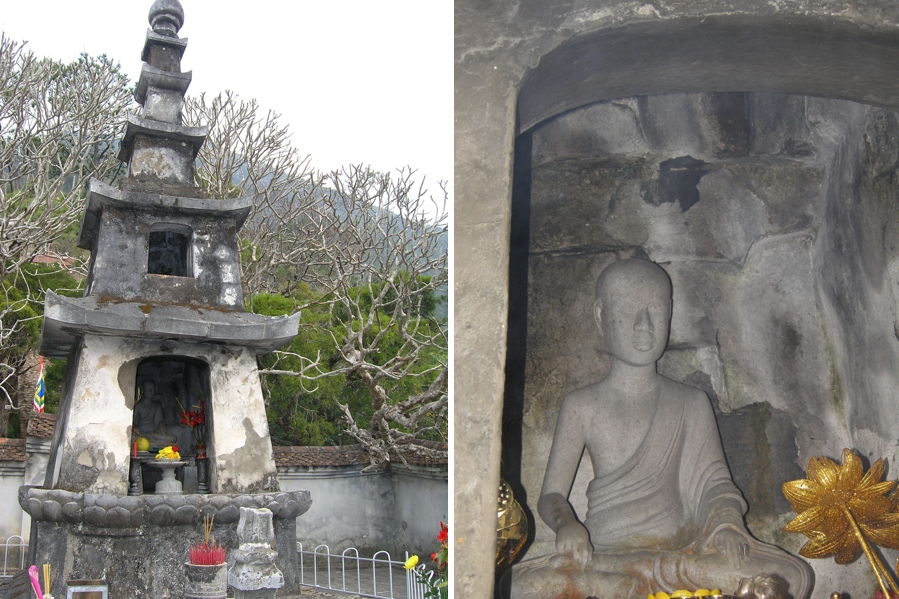
The tomb to Trần Nhân Tông (including the Huệ Quang tower, above) is a few hundred feet from the cable car station, but that's just the beginning of the path that continues up the mountain to the summit. Along the way, there are several other temples and shrines dedicated to Trần Nhân Tông or used by him. Perched on a cliff att the absolute peak of the mountain is a small temple-altar called the “Bronze Pagoda” (Chùa Đồng), with a row of bells that put one in mind of Tibet.
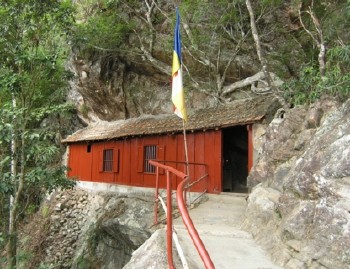 |
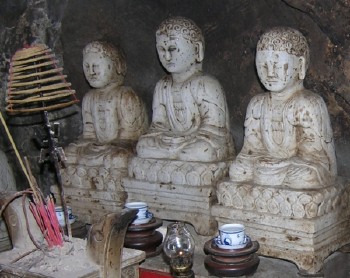 |
| Above the tomb and temple to Trần Nhân Tông is this sheltered sanctuary known as Chùa Một Mái (One-Roof Pagoda). The authors of "Chua Vietnam" describe it as "tottering" on the mountainside and say that it was flanked by brick towers, which are no longer in evidence. | The stone statues inside Chùa Một Mái are modest in size and pleasing in appearance; I have no information regarding their style or era. |
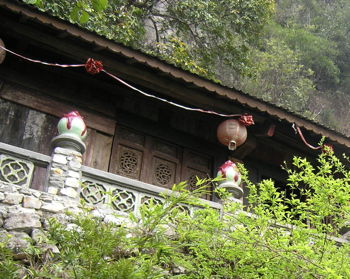 |
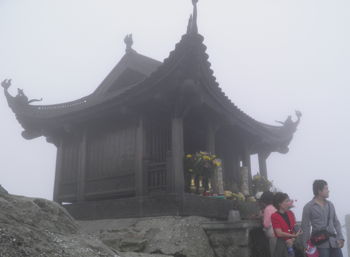 |
| Much further along the very steep trail, we came to the Bảo Sái shrine, which shelters an altar with traditional Buddhist and Taoist deities. We had the choice of going the rest of the way to the top or heading laterally to the Vân Tiêu pagoda. We chose to climb, knowing that we'd see Vân Tiêu on the way down. | Chùa Đồng, the "copper pagoda" at the very summit, 2010 visit. The temple was said to have been constructed all of copper at the behest of one of the wives of the Trịnh lords (late 16th or 17th Century). That temple was destroyed, and the present one was built in Nguyễn times, using iron. (The roof is said to be copper, but I’m not a metallurgist and can’t confirm.) |
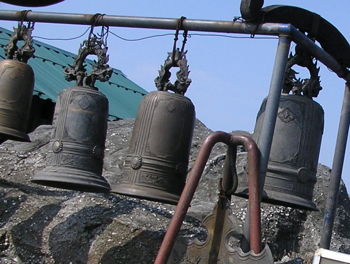 |
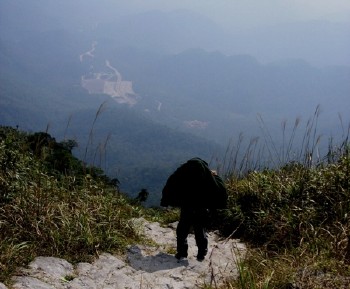 |
| The bells next to Chùa Đồng, on a bright sunny day in 2005. | The long way down--far below, you can see the lower ridges, with clouds drifting above them. |
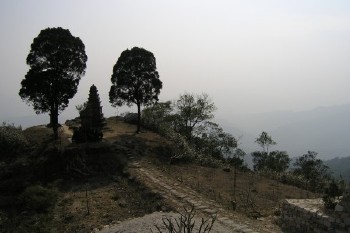 |
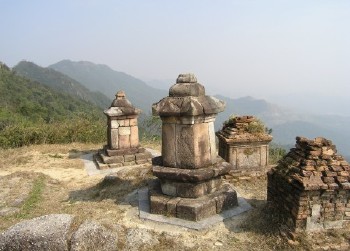 |
| Seen from the Vân Tiêu temple, the promontory with its stupa yard projects into the cloudy landscape. | Small memorial stupas for the eminent monks of the temple. |
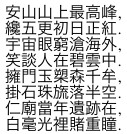
O'er Mt. Yên's tallest peak,
The pink dawn arises at the fifth watch.
My eyes exhaust the empyrean to the seas beyond,
Chitter chatter within the jasper clouds.
A pressing gate of jade lances o'er a thousand hectares dense,
Pearly gems of stone suspended in the void.
At Nhân's tomb one may still find,
His double pupils gleaming bright between the dot.
Nguyễn Trãi's homage to Trần Nhân Tông's tomb on Yên Tử, translated by Gino Pagliaccetti. Gino's additional comments:
"fifth watch" Time in traditional China (& Vietnam) was divided into watches or geng. A geng was 2 hours, and it is not religious, though 'vespers' or 'matins' might be suitable translations.
"pressing gate of jade lances" Probably an image of the steep mountain peaks surrounding Yên Tử.
"double pupils" Chinese tradition held that sage kings had double pupils.
The dot refers to the mark made between the eyes on Buddhist statues.
Scholars and legends of Chí Linh District
There are many other tombs and temples to the west of Yên Tử that pay homage to the famous figures of the Trần Dynasty. Đền Kiếp Bạc is the temple dedicated to Trần Hưng Đạo, the warrior-prince who coordinated the campaign against the Yuan invasion. A gallery next to the temple serves as a museum exhibiting historical maps and artifacts documenting his career.
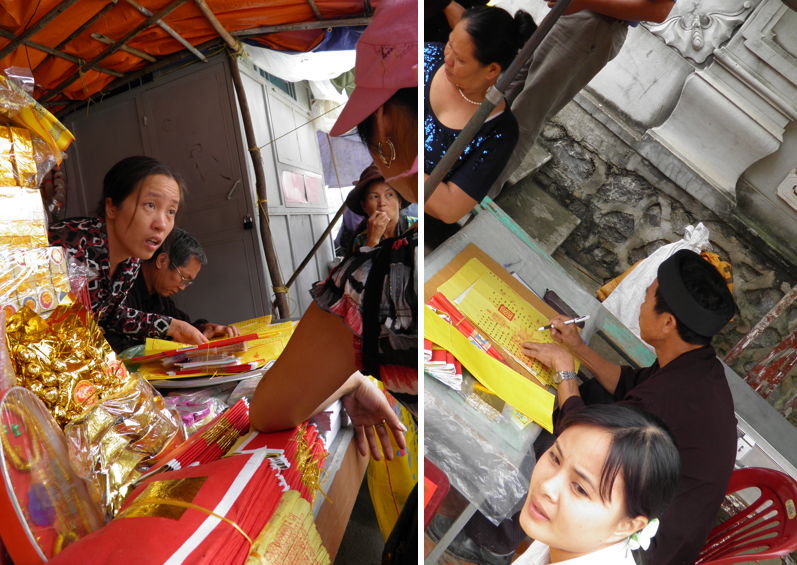
Woman selling incense and votive papers; a scholar (nhà nho) writes out supplicatory messages in Han script.
Below: Presentation of offerings at the central altar to Trần Hưng Đạo.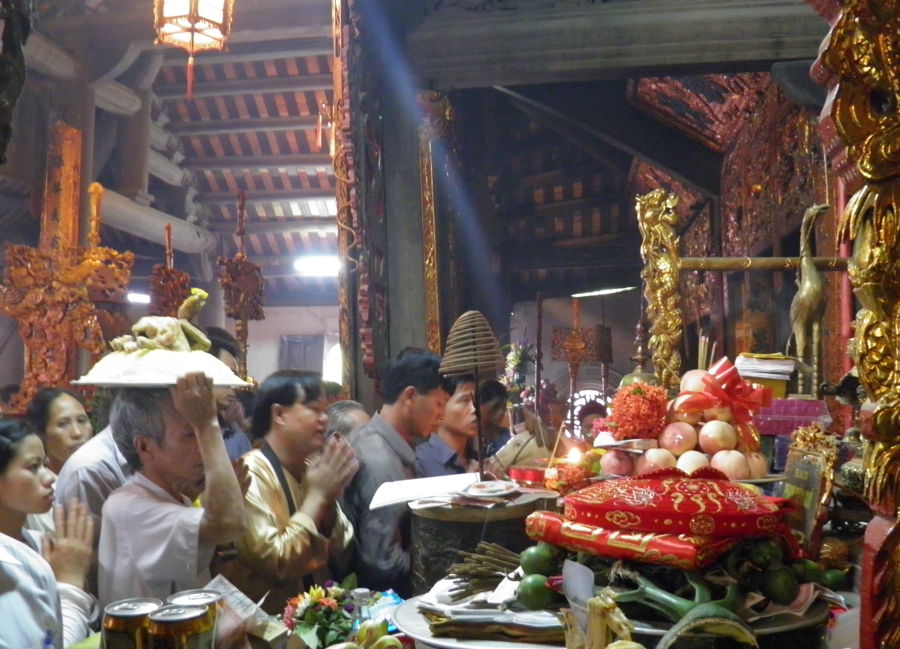
Nearby, on a mountain slope, are the temple and tomb of Chu Văn An, a famous scholar who presided over the national college in Thăng-long (adjacent to the Temple of Literature). During the debauched reign of one of the later Trần emperors, An recommended the execution of several unreliable mandarins by beheading. When the king decided against this, Chu Văn An retired to this pine-forested mountain retreat near Côn Sơn mountain. He did finally return to Thăng-long in 1370, after the 'debauched king' had died and his successor had been deposed.
Nearby, on a mountain slope, are the temple and tomb of Chu Văn An, a famous scholar who presided over the national college in Thăng-long (adjacent to the Temple of Literature). During the debauched reign of one of the later Trần emperors, An recommended the execution of several unreliable mandarins by beheading. When the king decided against this, Chu Văn An retired to this pine-forested mountain retreat near Côn Sơn mountain. He did finally return to Thăng-long in 1370, after the 'debauched king' had died and his successor had been deposed.
The writings of Chu Văn An and other scholars and kings of the Trần period frequently celebrate the pleasures of the contemplative life in this region, far from the distractions and worldly concerns of the capital. One of the poems posted in the smaller (perhaps "unofficial") temple to Chu Văn An describes the landscape of Chí Linh:
Rambling along a path of pines,
Lone village lost in the mists.
The tide returns, the flute recedes o'er the river,
The sky broadens, cloud tipped trees.
Roosting birds flutter in the clear dew,
Cold fish jump in the jade tarn.
Where did the flute player go?
Lone on the mountain west.
[Translation courtesy of Gino Pagliaccetti]
Another great mandarin who found solace in these wooded mountains was Nguyễn Trãi. Nguyễn Trãi belongs to the next era (Lê dynasty); he was the counselor and military advisor to Lê Lợi in the insurgency against the Ming occupation (1418-1428). He was also the author of the famous proclamation of independence after the great victory at the Chi-lăng Pass. Years later, Nguyễn Trãi also recommended the execution of a number of mandarins, and retired to these mountains when his advice was ignored.
That would have been a satisfactory ending to his distinguished career, but for the visit of the young king Lê Thái Tông in 1442. Lê Thái Tông took ill and died on his way back to the capital, and Trãi was accused of having joined in a plot to poison him. He and his family were put to death. Twenty years later, the scholarly emperor Lê Thánh Tông (see Văn Miếu) issued a royal edict exonerating Nguyễn Trãi and honoring him as a founding figure of the Lê Dynasty.
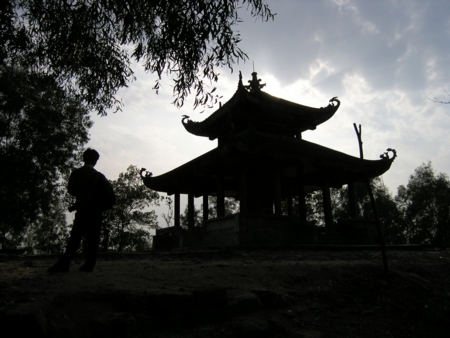
Silhouette of Bạch Vân pagoda.
The historic pagoda of Côn Sơn, which is associated with Nguyễn Trãi, is conveniently seated at the foot of a ridge. From there, one can take a demanding but rewarding hike through the pine-forested slopes to see the Bạch Vân (White Cloud) Shrine and the great views from that height. We came back down by another route, and passed the newly-erected đền to Nguyễn Trãi. As is often the case with these state-funded monuments, it is built in a standardized style of cold concrete and is devoid of the warmth and charm of a Vietnamese temple.
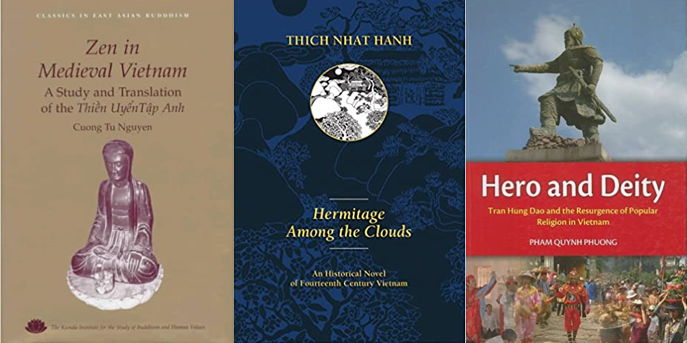
- The foremost authority on Trần Nhân Tông may be Lê Mạnh Thát, a renowned Buddhist scholar who taught at Vạn Hạnh University in Saigon (and was imprisoned for fourteen years for supporting the independent Buddhist church). Unfortunately, his books are very difficult to obtain. An Internet search may yield some online postings of his work (in English-language translations as well as Vietnamese), e.g., "A Complete Collection of Trần Nhân Tông 's Works" (Toàn Tập Trần Nhân Tông), "The Emperor Nhân Tông 's Monastic Life," "The Emperor Nhân Tông and the Trúc lâm School."
- Zen in Medieval Vietnam : A Study and Translation of the Thiền Uyển Tập Anh, Cuong Tu Nguyen, University of Hawai’I Press, 1997. The Thiền Uyển Tập Anh (Collection of Outstanding Figures of the Zen Garden) is a 14th century text recording the biographies of notable Vietnamese monks, including Trần Nhân Tônh. Cuong Tu Nguyen argues here and elsewhere (Essays into Vietnamese Pasts, 1995) that this is not a true “transmission of the lamp” text, recording the series of “direct transmissions” of enlightenment from a Zen master to his disciple.
- Hermitage among the Clouds, Thich Nhat Hanh, Parallax Press, 1993. Composed by the world renowned Buddhist teachers, this historical novel imagines the lives of emperor Trần Nhân Tông and Princess Huyền Trân. Though Thích Nhất Hạnh cannot help but romanticize the story, he takes history very seriously. One sees this in his reinterpretation of Huyền Trân’s escape from Champa.
- Trúc Lâm Buddhism in Vietnam: Its History, Development, and Legacy, Laura Thuy-Loan Nguyen, Cambridge Scholars Publishing (not affiliated with Cambridge University Press), 2021. I have not yet had a look this recent volume, but from the book description, it appears to be focused on the modern revival of the Trúc Lâm practice by Thích Thanh Từ.
- Hero and Deity: Tran Hung Dao and the Resurgence of Popular Religion in Vietnam, Pham Quynh Phuong, University of Washington Press (Mekong Press), 2009. An anthropological study of the cult of Trần Hưng Đạo.
- Tấu, biểu đấu tranh ngoại giao của Nguyễn Trãi; Les documents diplomatiques rédigés par Nguyễn Trãi au XVe siècle, (Documents of Diplomatic Campaigns by Nguyễn Trãi), by Nguyên Van Nguyên, EFEO - Coéditions, Viện Cao học Thực hành, 2003. This publication includes both French & Vietnamese quốc nữ translations of the original text.
- The History of Buddhism in Vietnam, edited by Nguyen Tai Thu, Social Sciences Publishing House, 1992; reprint by Council for Research in Values & Philosophy, 2009. Contributions by various scholars and presumably vetted and possibly redacted by the government’s ministry of culture.
- An Anthology of Vietnamese Poems: From the Eleventh Through the Twentieth Centuries (Huynh Sanh Thong, Yale University Press). An excellent collection, though weighted heavily towards the modern era. Sadly, A Thousand Years of Vietnamese Poetry (Nguyen Ngoc Bich with W.S. Merwin, Random House, 1975) is out of print.
